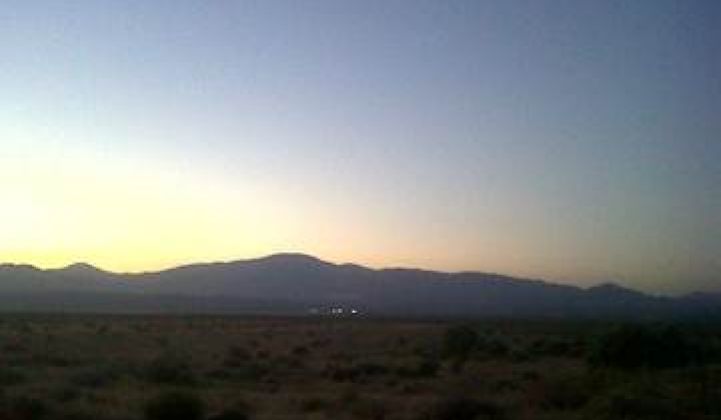At the front lines of First Solar’s fight for its Antelope Valley Solar Ranch One solar power plant and NextEra Energy’s fight for its Blue Sky wind project, serious, dedicated people are locked in contention.
Behind them are hungry people who desperately want jobs and frightened people who fear that the quality of their peaceful lives is about to be lost forever.
With some 13 renewables projects in the works and perhaps twenty more planned, Antelope Valley’s roughly 27,000 acres of high desert lands are poised to become a renewable energy engine unlike anything ever seen before.
The two driving forces: (1) A renewables standard requiring California to obtain a third of its power from renewables by 2020, a near doubling of present capacities, and (2) new Governor Jerry Brown’s determination to meet the standard, typified by his recent call for authorities to “push” and, if necessary, to “crush” opposition.
At recent job fairs held by First Solar, an estimated 400+ men and women stood in line in the desert heat to submit applications for the construction jobs at the first of the Antelope Valley (AV) solar projects. In the lines were faces looking for a chance, many with a defeated look of flagging hope. Many were still youthfully innocent.
One young man, a graduate of the Kern County Community College renewable energy certificate program who has unsuccessfully submitted more than 60 job applications to projects all over the country, had confidence in his voice and promise in his eyes as he talked about what he had learned in earning his certificate. It leaked out as he described the rejections.

The job fairs represent First Solar’s fulfillment of the first in a series of demands made on them by Antelope Valley leaders, noted Norm Hickling, Field Deputy for Los Angeles County Supervisor Mike Antonovich, who is “facilitating meetings between those parties so we can have that dialogue.”
The turnout was an indication of how important getting differences settled is, acknowledged Richard Skaggs, a veteran of Washington and Sacramento politics who is now active with one of the Valley’s town councils.
The very lives of the people in need of the First Solar jobs hang in the balance.
But there are stakes that reach beyond the First Solar project. Getting the template right for agreements with all the renewables developers in line behind First Solar is crucial. AV’s leaders intend to have a say in the appearance and handling of the projects that will be in their faces long after the developers are earning equity and counting profits.
Nowhere is this intent more passionate than with Lakes Communities residents who live just over Portal Ridge from NextEra Energy’s $400 million, 200-megawatt Blue Sky wind project.
To a non-resident’s eyes, NextEra’s simulations give its project a benign, unobtrusive appearance -- but non-residents won’t be looking it every day and every night. “Blue Sky is green energy destroying a green environment,” said one resident. “Is that green?”
Vocal locals seem unimpressed by the $240 million in direct local economic benefits, including new local sales tax and property tax revenues, workers’ salaries, operations and maintenance, and land lease payments that NextEra says the Blue Sky project will create.
“Turbines do not belong on Portal Ridge or at the poppy reserve,” declared Susan Zanter at a recent town council meeting.
“This is something we can stop,” Cindy Romano told her fellow Valley residents.
_540_449_80.jpg)
The worst part of their opposition to the project is that the project's perceived intrusiveness is creating enemies for wind.
At the Lakes Communities’ 49er Day summer social event, wind opponents distributed literature asserting the health dangers of “wind turbine syndrome” that have been discredited by thorough medical reviews in the U.S. and Canada. The literature also made much of wind’s dependence on federal subsidies without accurately noting how much more heavily subsidized the nuclear and fossil fuel industries have been over the last several decades. It drew on outdated misinformation and discredited studies available on the internet to negatively portray other nations’ and states’ very favorable experiences with wind.
Lakes Communities residents are strong proponents for distributed renewables. Many would build solar panels and small wind if they could afford them. However, they are deeply concerned about utility-scale wind turbines’ blinking lights.
It is entirely understandable that these folks don’t want wind on their hills and not surprising that in their passionate need to combat it they would turn to internet misinformation that can be difficult for laypeople to discern as being inaccurate.
Developers are unlikely to win these people over with rational arguments. They just don’t want to hear it.
Is there a way to get renewables and the jobs they bring while at the same time protecting private rights and the beauty of the area's mountains and valleys?
Yes, suggested members of one of the Valley’s town councils who did not want to be quoted by name. There are tremendous benefits to communities that embrace renewable energy, said one. In communities where recalcitrants make up the majority, let them miss out.
Where renewables developers are welcomed, said another, they should offer the same kind of wealth-sharing that energy companies have always offered and go the one step farther that others haven’t to protect the locality with careful siting and conscientious mitigation efforts.
Renewables developers, they were essentially saying, must not only do the right thing -- but they must do it the right way.



